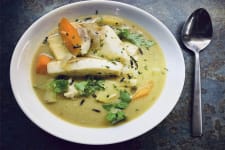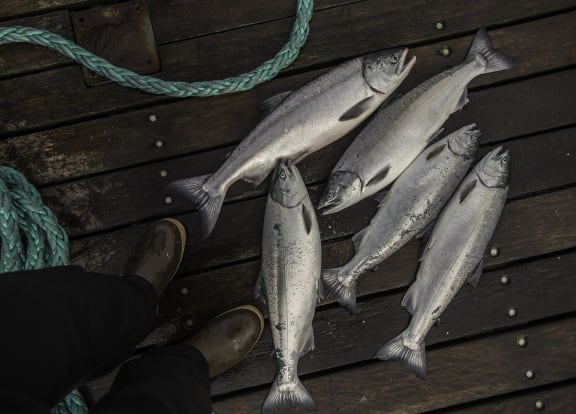
Types of Salmon: Your Go-To Guide
March 21st, 2023Fast Facts About 6 Different Salmon Species
Wild salmon are keystone species in Alaska, where this family of fish supports a vibrant web of flora and fauna. There are several species of salmon that coexist in this unique Arctic ecosystem.
Five different salmon types are native to Alaska and other Pacific ecosystems off the continents of North America and Asia. There’s also one type of salmon that is native to Atlantic ecosystems, off North America as well as Europe.
Each species of salmon has particular characteristics in terms of appearance, flavor, texture, and fat content. These differences are the result of unique lifecycles that include unique diets, habits, and lifespans.
What Are the Different Types of Salmon?
The different types of salmon include king (chinook), coho, pink, sockeye, atlantic, and chum salmon. All six types of salmon can be found off of North America, with wild fish populations in both Pacific and Atlantic ecosystems.
It’s important to note that Atlantic salmon are endangered in the wild, in both North America and Europe. When you see Atlantic salmon at a market, it was produced at a salmon farm. Salmon farms have been constructed all around the world to produce farmed Atlantic salmon.
Types of Salmon & Their Differences
Each of the six types of salmon has its own unique appearance, taste, texture, and nutritional profile. For additional context, Will Rogers, Seafood Category Manager for Wild Alaskan Company, shared his expertise to explain how each of the Pacific species relates to the greater Alaskan fishing industry.
King Salmon / Chinook Salmon
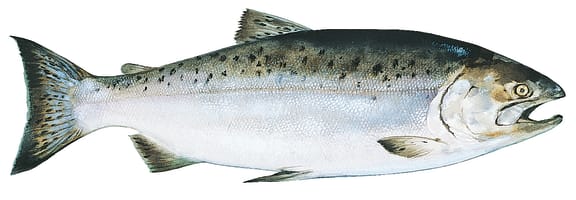
-
Largest species
-
Naturally tends to be higher in fat content
- Fillets are light pink to red-orange in color, sometimes with grayish tones
King salmon, also known as chinook salmon, is the biggest species within the salmon family, weighing in at an average of 30 pounds. It spends much of its life feeding at sea, so its fat content tends to be higher than other species of salmon. Copper River king salmon is especially fatty.
Fillets of king salmon can be pink or red-orange in color, sometimes with muted gray tones. Fillets can be visibly marbled with fat. Occasionally, king salmon fillets are not pink but ivory, due to a genetic mutation.
King salmon is the state fish of Alaska, where it’s commercially fished throughout the year. Certain king salmon fisheries have seen sharp population declines, likely as a result of climate-related changes. To ensure that king salmon from Alaska is harvested sustainably, only those fisheries with robust king salmon populations are open for commercial fishing.
Sockeye Salmon

-
Bright red fillets, usually without visible marbling
-
Bold flavor
Sockeye salmon is easily identifiable compared to other species of salmon, due to its bright red fillets. The bold red color of sockeye has earned it the nickname red salmon. It gets this unmistakable color from a diet especially rich in zooplankton.
This diet also contributes to sockeye’s robust flavor profile and dense texture. Sockeye is delicious with simple seasonings, or when paired with bold ingredients. Because of these qualities, smoked salmon products are often made with sockeye.
Sockeye salmon is the second most abundant salmon species in Alaska. “Alaska’s Bristol Bay is home to the largest sockeye spawning ground on the globe,” noted Rogers. It’s an iconic Alaskan catch — one that the Wild Alaskan Company co-founder Arron Kallenberg grew up harvesting with his father Walt Kallenberg on the Mary K.
Coho Salmon / Silver Salmon

-
Delicate texture
-
Mild flavor
- Fillets are pink to red-orange in color
Coho salmon is also known as silver salmon for its bright, shiny skin. Its fillets are less red than sockeye — more pink to red-orange in color. Coho salmon are leaner than king salmon, so you won’t be able to see much marbling in coho fillets.
Coho salmon are leaner than sockeye salmon, too, with a higher protein and lower fat content. It also has a milder flavor profile and a visibly softer texture. “Coho is a nice counterpart to sockeye because it has a more delicate taste and flake,” said Rogers. “That’s why it’s been part of the Wild Alaskan Company base box since day one.”
Pink Salmon
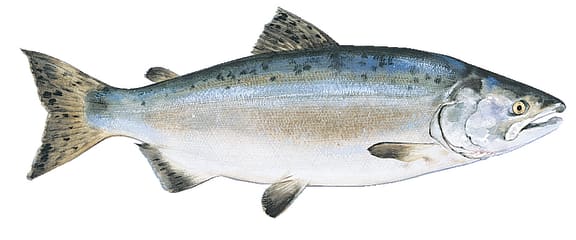
-
Popular variety for canned salmon
-
Most abundant species
- Light pink fillets
Pink salmon is the most abundant species of salmon in the Pacific. It’s named after the pink color of its fillets.
Pink salmon is especially mild in flavor, making it a great blank slate for different preparations of salmon. “A vast majority of pink salmon goes into canned products or is used in salmon burgers,” explained Rogers. “Pink salmon is also a high value fishery for roe.”
Chum Salmon / Keta Salmon
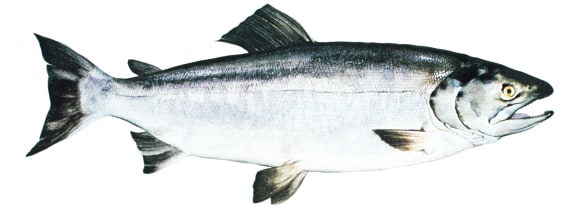
-
Traditionally used for preservation
-
Known for their roe
Chum salmon is the most underappreciated species of salmon. Commercially, it was used mostly for roe. However, properly handled chum salmon produces a mild, lean, and flaky fillet. Chum salmon usually grow to be around 12 pounds, which is comparable to sockeye salmon in size.
“The value in Chum Salmon has historically been found in their roe, rather than for their fillets,” noted Rogers, “but with better processing practices in place, the fillet market and quality is increasing.”
Traditionally, chum salmon has been an important species for preservation, but it’s becoming more widely available to the general public. It was recently rebranded as keta salmon to give this catch a more appetizing name.
Atlantic Salmon
-
Unnaturally large and fatty
- Fillets range in color from pink to red-orange depending on proportion of dye in feed
-
Bland flavor
Commercial fishing of Atlantic salmon is prohibited in the U.S. and Canada, and either extremely limited or entirely prohibited in both the U.K. and Europe, due to dangerously small wild populations.
Any Atlantic salmon you find at the store is farmed. They tend to be quite large and unnaturally fatty, due to the conditions in which they are produced. They’re fed food that has been colored with dyes, which give the fillets an artificial pink color. A fillet of farmed salmon is high in calories and may contain dangerous levels of chemical contamination.
The differences between farmed salmon and wild salmon go beyond the availability and flavor of the fish on your table.
Which Type of Salmon Is Best?
1. King (Chinook) Salmon
Best for: People looking to prepare an extra special meal.
2. Sockeye (Red) Salmon
Best for: People who enjoy bold flavors and cooking methods. Great for grilling.
3. Coho (Silver) Salmon
Best for: First time salmon-eaters or people who prefer delicate preparations and ingredients pairings.
4. Chum (Keta) Salmon
Best for: People looking for an especially affordable type of salmon.
5. Pink Salmon
Best for: People looking for a mild, everyday option, since pink salmon is typically canned.
FAQs on Salmon Harvesting and Processing
Where is Wild Alaskan Company's salmon sourced?
Wild Alaskan Company sources each species of wild salmon from sustainably managed fisheries in Alaska.
Is wild Alaska salmon from Wild Alaskan Company processed abroad?
No, Wild Alaskan Company's offerings are never processed abroad. Each species of wild salmon is processed at either a local facility in Alaska or in the Pacific Northwest.
Where to Buy the Best Type of Salmon
Buy salmon online through a Wild Alaskan Company membership to see how we make seafood shopping easier and more convenient. You'll get high-quality fish delivered straight to your doorstep. Each variety of salmon included in a seafood delivery box is always wild-caught and sourced from sustainable fisheries in Alaska.


